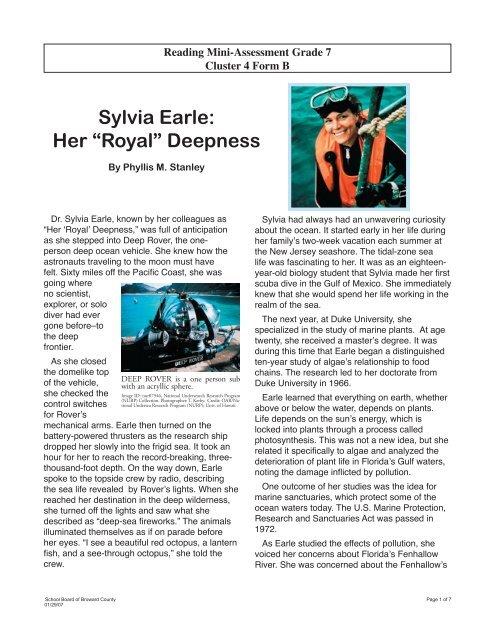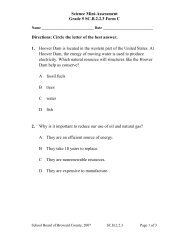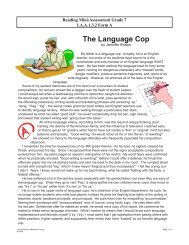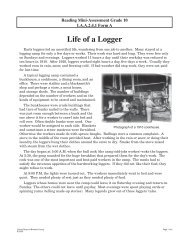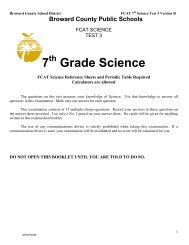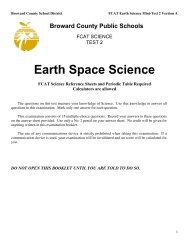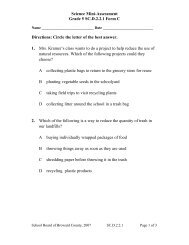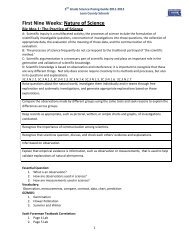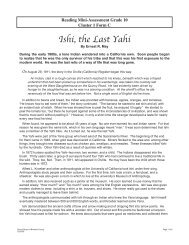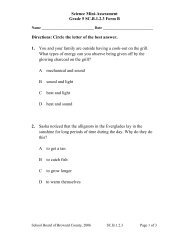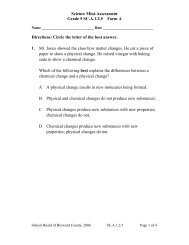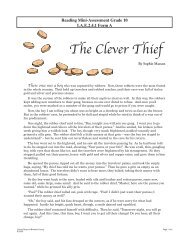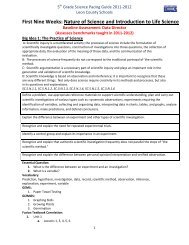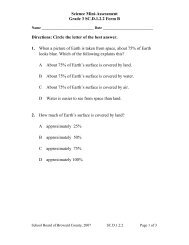Sylvia Earle: Her âRoyalâ Deepness
Sylvia Earle: Her âRoyalâ Deepness
Sylvia Earle: Her âRoyalâ Deepness
- No tags were found...
Create successful ePaper yourself
Turn your PDF publications into a flip-book with our unique Google optimized e-Paper software.
Reading Mini-Assessment Grade 7Cluster 4 Form B<strong>Sylvia</strong> <strong>Earle</strong>:<strong>Her</strong> “Royal” <strong>Deepness</strong>By Phyllis M. StanleyDr. <strong>Sylvia</strong> <strong>Earle</strong>, known by her colleagues as“<strong>Her</strong> ‘Royal’ <strong>Deepness</strong>,” was full of anticipationas she stepped into Deep Rover, the onepersondeep ocean vehicle. She knew how theastronauts traveling to the moon must havefelt. Sixty miles off the Pacific Coast, she wasgoing whereno scientist,explorer, or solodiver had evergone before–tothe deepfrontier.As she closedthe domelike topof the vehicle,she checked thecontrol switchesfor Rover’sDEEP ROVER is a one person subwith an acryllic sphere.Image ID: nur07546, National Undersearch Research Program(NURP) Collection. Photographer: T. Kerby. Credit: OAR/NationalUndersea Research Program (NURP); Univ. of Hawaiimechanical arms. <strong>Earle</strong> then turned on thebattery-powered thrusters as the research shipdropped her slowly into the frigid sea. It took anhour for her to reach the record-breaking, threethousand-footdepth. On the way down, <strong>Earle</strong>spoke to the topside crew by radio, describingthe sea life revealed by Rover’s lights. When shereached her destination in the deep wilderness,she turned off the lights and saw what shedescribed as “deep-sea fireworks.” The animalsilluminated themselves as if on parade beforeher eyes. “I see a beautiful red octopus, a lanternfish, and a see-through octopus,” she told thecrew.<strong>Sylvia</strong> had always had an unwavering curiosityabout the ocean. It started early in her life duringher family’s two-week vacation each summer atthe New Jersey seashore. The tidal-zone sealife was fascinating to her. It was as an eighteenyear-oldbiology student that <strong>Sylvia</strong> made her firstscuba dive in the Gulf of Mexico. She immediatelyknew that she would spend her life working in therealm of the sea.The next year, at Duke University, shespecialized in the study of marine plants. At agetwenty, she received a master’s degree. It wasduring this time that <strong>Earle</strong> began a distinguishedten-year study of algae’s relationship to foodchains. The research led to her doctorate fromDuke University in 1966.<strong>Earle</strong> learned that everything on earth, whetherabove or below the water, depends on plants.Life depends on the sun’s energy, which islocked into plants through a process calledphotosynthesis. This was not a new idea, but sherelated it specifically to algae and analyzed thedeterioration of plant life in Florida’s Gulf waters,noting the damage inflicted by pollution.One outcome of her studies was the idea formarine sanctuaries, which protect some of theocean waters today. The U.S. Marine Protection,Research and Sanctuaries Act was passed in1972.As <strong>Earle</strong> studied the effects of pollution, shevoiced her concerns about Florida’s FenhallowRiver. She was concerned about the Fenhallow’sSchool Board of Broward County Page 1 of 701/29/07
Reading Mini-Assessment Grade 7Cluster 4 Form Bimpact on river life and on the sea-grassmeadows as it flowed into the Gulf. She sawcreatures she had known as a child—sea horses,puffer fish, pink urchins, basket stars—diminish innumbers, and then disappear.She also observed the damage to underseasystems caused by the dredging operations inTampa Bay in the nineteen fifties and nineteensixties. No one listened to her warnings aboutocean damage.<strong>Earle</strong> realized that she would have to gain widerexperience and become more knowledgeable inthe field of marine science before anyone wouldhear her plea for the oceans. She knew that amajor obstacle to ocean research, like spaceresearch, would be getting there—going deepenough to discover all the parts of the oceanecosystem.In the nineteen seventies, biosphereexperiments were beingconducted to find outhow human beings wouldreact to extended isolationin space and under thesea. The United Statesgovernment sponsored theTektite 1 and 2 underwaterresearch projects.In the Tektite 2 project,<strong>Earle</strong> headed an all-femaleteam of four other marineDr. <strong>Sylvia</strong> <strong>Earle</strong> displayssamples to an aquanautinside the Tektite.Image ID: nur08002, National UndersearchResearch Program (NURP) Collection.Credit: OAR/National UnderseaResearch Program (NURP)scientists living fifty feet underwater for twoweeks near a coral reef in the Virgin Islands. Theaquanauts lived in a four-room habitat composedof two towers. One tower contained a lockouthatch 1 and support equipment. The other towercontained comfortable living quarters with warmshowers and hot meals.This type of “saturation diving” permittedunhurried observations. <strong>Earle</strong> classified andcataloged the plants in the area. Of the 153species of plants that she observed, 26 had neverbefore been seen in the coastal waters. She usedher camera to document her discoveries. Whenthe scientists emerged from their two weeks ofisolation, they were hailed as heroes, given aticker-tape parade in Chicago, and invited to theWhite House. The Tektite experiment had beena success both in terms of the scientists’ provenability to live underwater and in the data theygathered.Tektite had provided <strong>Sylvia</strong> with a uniqueopportunity to introduce the public to the deepfrontier because of her firsthand knowledge ofocean life. As <strong>Earle</strong> accepted invitations to speakof her discoveries, she used the opportunity toalso deliver warnings about ocean pollution. Invarious articles and speeches she declared theresponsibility all humanity shares to protect theocean’s incredible diversity of life. She said, “Theocean covers nearly three-quarters of our planet,and about ninety percent of all living things arefound there.”1lockout hatch: an airtight door leading outside<strong>Sylvia</strong> <strong>Earle</strong>: <strong>Her</strong> “Royal” <strong>Deepness</strong> by Phyllis M. Stanley, from American Environmental <strong>Her</strong>oes, copyright 1996 by Enslow Publishers, Inc. Photographs by Al Giddings Images, Inc. Reprinted by permission ofthe author and the photographerSchool Board of Broward County Page 2 of 701/29/07
Reading Mini-Assessment Grade 7Cluster 4 Form BName __________________________________________ Date ___________________Directions: Read the passage “<strong>Sylvia</strong> <strong>Earle</strong>: <strong>Her</strong> ‘Royal’ <strong>Deepness</strong>,” then circle the letter of the correctanswer.1. What kind of evidence does the author, Phyllis Stanley, use most in this article?A. She provides facts and details about <strong>Sylvia</strong> <strong>Earle</strong>’s research.B. She relates her own personal experiences with undersea exploration.C. She gives her opinions about the effects of ocean pollution.D. She relies on the reader’s curiosity about the study of marine life.2. People who read this article will learn that marine sanctuaries were first establishedA. to protect sea life from pollution.B. to serve as underwater laboratories.C. to give researchers a place to observe sea life.D. to provide scientists with a place to do team diving.3. How were the results of the underwater Tektite 2 experiment also important to space research?A. Tektite 2 revealed the importance of observations during research projects.B. Tektite 2 showed how humans react to extended isolation.C. Tektite 2 proved photographs should be used to support discoveries.D. Tektite 2 demonstrated that major obstacles to research existed.4. People who read this article will learn thatA. <strong>Sylvia</strong> <strong>Earle</strong>’s most important work was done in the Deep Rover.B. <strong>Sylvia</strong> <strong>Earle</strong> was deeply concerned about ocean pollution.C. the Tektite 2 project would have failed without <strong>Sylvia</strong> <strong>Earle</strong>’s leadership.D. the public was first made aware of photosynthesis because of <strong>Sylvia</strong> <strong>Earle</strong>’s research.School Board of Broward County Page 3 of 701/29/07
Reading Mini-Assessment Grade 7Cluster 4 Form B5. This article could best be used as a source for a student research project onA. causes of ocean pollution.B. photosynthesis in ocean plants.C. ways of classifying deep-sea plants.D. the exploration of marine ecosystems.6. Which of the following is the best evidence that the Tektite 2 project was valid for scientificadvancement?A. The Tektite 2 project was conducted in coastal waters near a coral reef.B. The Tektite 2 project confirmed scientists’ concerns of diminishing ocean life.C. The Tektite 2 project showed the effect of ocean pollution on algae in plants.D. The Tektite 2 project provided new data on a variety of plant species.7. What was the greatest benefit to the public from <strong>Sylvia</strong> <strong>Earle</strong>’s participation in the Tektite 2 project?A. She documented for the public that the experiment had been a success.B. She classified and catalogued plants that the public had never been seen before.C. She educated the public by giving speeches about the ocean and warning about its pollution.D. She provided the public with proof that aquanauts could live in extended isolation underwater.8. Which of the following statements best supports the idea that <strong>Sylvia</strong> <strong>Earle</strong>’s Deep Rover experience issimilar to her participation in the Tektite 2 experiment?A. During each project, she spent about two weeks underwater.B. Both projects involved teams of scientists working together underwater.C. For both projects, she observed sea life underwater.D. Both projects took place at a depth of about three thousand feet.School Board of Broward County Page 4 of 701/29/07
Reading Mini-Assessment Grade 7Cluster 4 Form BANSWER KEY – <strong>Sylvia</strong> <strong>Earle</strong> – LA.A.2.3.5, LA.A.2.3.8LA.A.2.3.5: obtain information through recognizing, identifying, analyzing, synthesizing, and/or evaluating, within or across textsLA.A.2.3.8: validity and accuracy, fact and opinion, strong v. weak arguments, within or across texts1. What kind of evidence does the author, Phyllis Stanley, use most in this article?A. She provides facts and details about <strong>Sylvia</strong> <strong>Earle</strong>’s research.B. She relates her own personal experiences with undersea exploration.C. She gives her opinions about the effects of ocean pollution.D. She relies on the reader’s curiosity about the study of marine life.LAA2382. People who read this article will learn that marine sanctuaries were first establishedA. to protect sea life from pollution.B. to serve as underwater laboratories.C. to give researchers a place to observe sea life.D. to provide scientists with a place to do team diving.LAA2353. How were the results of the underwater Tektite 2 experiment also important to space research?A. Tektite 2 revealed the importance of observations during research projects.B. Tektite 2 showed how humans react to extended isolation.C. Tektite 2 proved photographs should be used to support discoveries.D. Tektite 2 demonstrated that major obstacles to research existed.LAA2354. People who read this article will learn thatA. <strong>Sylvia</strong> <strong>Earle</strong>’s most important work was done in the Deep Rover.B. <strong>Sylvia</strong> <strong>Earle</strong> was deeply concerned about ocean pollution.C. the Tektite 2 project would have failed without <strong>Sylvia</strong> <strong>Earle</strong>’s leadership.D. the public was first made aware of photosynthesis because of <strong>Sylvia</strong> <strong>Earle</strong>’s research.LAA235School Board of Broward County Page 5 of 701/29/07
Reading Mini-Assessment Grade 7Cluster 4 Form BANSWER KEY – <strong>Sylvia</strong> <strong>Earle</strong> – LA.A.2.3.5, LA.A.2.3.8 – Page 25. This article could best be used as a source for a student research project onA. causes of ocean pollution.B. photosynthesis in ocean plants.C. ways of classifying deep-sea plants.D. the exploration of marine ecosystems.LAA2356. Which of the following is the best evidence that the Tektite 2 project was valid for scientificadvancement?A. The Tektite 2 project was conducted in coastal waters near a coral reef.B. The Tektite 2 project confirmed scientists’ concerns of diminishing ocean life.C. The Tektite 2 project showed the effect of ocean pollution on algae in plants.D. The Tektite 2 project provided new data on a variety of plant species.LAA2387. What was the greatest benefit to the public from <strong>Sylvia</strong> <strong>Earle</strong>’s participation in the Tektite 2 project?A. She documented for the public that the experiment had been a success.LAA238B. She classified and catalogued plants that the public had never been seen before.C. She educated the public by giving speeches about the ocean and warning about its pollution.D. She provided the public with proof that aquanauts could live in extended isolation underwater.8. Which of the following statements best supports the idea that <strong>Sylvia</strong> <strong>Earle</strong>’s Deep Rover experience issimilar to her participation in the Tektite 2 experiment?A. During each project, she spent about two weeks underwater.B. Both projects involved teams of scientists working together underwater.C. For both projects, she observed sea life underwater.D. Both projects took place at a depth of about three thousand feet.LAA238School Board of Broward County Page 6 of 701/29/07
Reading Mini-Assessment Grade 7Cluster 4 Form BANSWER KEY – <strong>Sylvia</strong> <strong>Earle</strong> – LA.A.2.3.5, LA.A.2.3.8LA.A.2.3.5: obtain information through recognizing, identifying, analyzing, synthesizing, and/or evaluating, within or across textsLA.A.2.3.8: validity and accuracy, fact and opinion, strong v. weak arguments, within or across textsItem #AnswerBenchmark1. A LAA2382. A LAA2353. B LAA2354. B LAA2355. D LAA2356. D LAA2387. C LAA2388. C LAA238School Board of Broward County Page 7 of 701/29/07


